Shelf Life and Safety of Vacuum Packed HPP-Treated Soaked Cod Fillets: Effects of Salt Content and Multilayer Plastic Film
Abstract
1. Introduction
2. Materials and Methods
2.1. Samples Collection
2.2. Samples Preparation
2.3. Packaging and HPP Treatment
2.4. Chemical Analysis
2.5. Microbiological Analysis
2.6. Statistical Analysis
3. Results
3.1. Chemical Analysis
3.2. Microbiological Analysis: Salted and Soaked Products
3.3. HPP Products, OTR, and Shelf Life Evaluation
4. Discussion
5. Conclusions
Author Contributions
Funding
Institutional Review Board Statement
Informed Consent Statement
Data Availability Statement
Acknowledgments
Conflicts of Interest
References
- Chen, J.; Jayachandran, M.; Bai, W.; Xu, B. A critical review on the health benefits of fish consumption and its bioactive constituents. Food Chem. 2022, 369, 130874. [Google Scholar] [CrossRef]
- Genovese, J.; Tappi, S.; Tylewicz, U.; D’Elia, F.; De Aguiar Saldanha Pinheiro, A.C.; Rocculi, P. Dry-salted cod (Gadus morhua) rehydration assisted by pulsed electric fields: Modelling of mass transfer kinetics. J. Sci. Food Agric. 2022, 10, 11852. [Google Scholar] [CrossRef]
- Bjørkevoll, I.; Olsen, R.L.; Skjerdal, O.T. Origin and spoilage potential of the microbiota dominating genus Psychrobacter in sterile rehydrated salt-cured and dried salt-cured cod (Gadus morhua). Int. J. Food Microbiol. 2003, 84, 175–187. [Google Scholar] [CrossRef] [PubMed]
- Lorentzen, G.; Ytterstad, E.; Olsen, R.L.; Skjerdal, T. Thermal inactivation and growth potential of Listeria innocua in rehydrated salt-cured cod prepared fro ready-to-eat products. Food Control 2010, 21, 1121–1126. [Google Scholar] [CrossRef]
- Van Nassau, T.J.; Lenz, C.A.; Scherzinger, A.S.; Vogel, R.F. Combination of endolysins and high pressure to inactivate Listeria monocytogenes. Food Microbiol. 2017, 68, 81–88. [Google Scholar] [CrossRef] [PubMed]
- Arnaud, C.; de Lamballerie, M.; Pottier, L. Effect of hugh pressure processing on the preservation of frozen and re-thawed sliced cod (Gadus morhua) and salmon (Salmo salar) fillets. High Press. Process. 2018, 38, 62–79. [Google Scholar] [CrossRef]
- Oliveira, F.A.d.; Neto, O.C.; Santos, L.M.R.d.; Ferreira, E.H.R.; Rosenthal, A. Effect of high pressure on the fish meat quality—A review. Trends Food Sci. Technol. 2017, 66, 1–19. [Google Scholar] [CrossRef]
- Zhang, Z.; Britt, I.J.; Tung, M.A. Permeation of oxygen and water vapor through EVOH films as influenced by relative humidity. J. Appl. Polymer Sci. 2001, 82, 1866–1872. [Google Scholar] [CrossRef]
- Venkateshaiah, A.; Timmins, R.L.; Sehl, E.; Waclawek, S.; Černík, M.; Padil, V.V.T.; Agarwal, S. High barrier, biodegradable nanocomposite films based on clay-coated and chemically modified Gum Kondagogu. Macromol. Mater. Engin. 2022, 4, 22000008. [Google Scholar] [CrossRef]
- European Food Safety Authority (EFSA); Panel on Food Contact Materials, Enzymes and Processing Aids (CEP); Lambré, C.; Barat Baviera, J.M.; Bolognesi, C.; Chesson, A.; Cocconcelli, P.S.; Crebelli, R.; Gott, D.M.; Grob, K.; et al. Identification and prioritisation for risk assessment of phthalates, structurally similar substances and replacement substances potentially used as plasticisers in materials and articles intended to come into contact with food. EFSA J. 2022, 20, e07231. [Google Scholar] [CrossRef]
- Rode, T.M.; Rotabakk, B.T. Extending shelf life of desalted cod by high pressure processing. Inn. Food Sci. Emerg. Dis. 2021, 69, 102476. [Google Scholar] [CrossRef]
- ISO 15763:2010; Foodstuffs—Determination of Trace Elements—De-Termination of Arsenic, Cadmium, Mercury and Lead in Foodstuffs by Inductively Coupled Plasma Mass Spectrometry (ICP-MS) after Pressure Digestion. ISO: Geneva, Switzerland, 2010. Available online: https://www.en-standard.eu/une-en-15763-2010-foodstuffs-determination-of-trace-elements-determination-of-arsenic-cadmium-mercury-and-lead-in-foodstuffs-by-inductively-coupled-plasma-mass-spectrometry-icp-ms-after-pressure-digestion/ (accessed on 13 March 2022).
- ISO 13805:2014; Determination Foodstuffs—Determination of Traces Elements—Pressure Digestion. ISO: Geneva, Switzerland, 2014. Available online: https://standards.iteh.ai/catalog/standards/cen/5121a7d5-71d6-47ca-8393-226941610145/en-13805-2014 (accessed on 13 March 2022).
- ISO 2917:1999; Measurement of pH—Reference Method. ISO: Geneva, Switzerland, 1999. Available online: https://www.iso.org/standard/24785.html (accessed on 13 March 2022).
- ISO 21807:2004; Microbiology of Food and Animal Feeding Stuffs—Determination of Water Activity. ISO: Geneva, Switzerland, 2004. Available online: https://www.iso.org/standard/34728.html (accessed on 13 March 2022).
- AOAC 937.09; Salt Content (Chlorine as Sodium Chloride) in Seafood. AOAC: Rockville, MA, USA, 1937. Available online: http://www.aoacofficialmethod.org/index.php?main_page=product_info&products_id=2174 (accessed on 13 March 2022).
- ISO 4833:2013; Microbiology of the Food Chain—Horizontal Method for the Enumeration of Microorganisms—Part 1: Colony Count at 30 °C by the Pour Plate Technique. ISO: Geneva, Switzerland, 2013. Available online: https://www.iso.org/standard/53728.html (accessed on 2 April 2022).
- ISO 17410:2019; Microbiology of the Food Chain—Horizontal Method for the Enumeration of Psychrotrophic Microorganisms. ISO: Geneva, Switzerland, 2019. Available online: https://www.iso.org/standard/67437.html (accessed on 2 April 2022).
- ISO 11290-1,2:2017; Horizontal Method for the Detection and Enumeration of Listeria Monocytogenes and of Listeria spp.—Part 1: Detection Method; Part 2: Enumeration Method. ISO: Geneva, Switzerland, 2017. Available online: https://www.iso.org/standard/60313.html (accessed on 2 April 2022).
- ISO 6579-1,2:2020; Horizontal Method for the Detection, Enumeration and Serotyping of Salmonella—Part 1: Detection Method; Part 2: Enumeration Method. ISO: Geneva, Switzerland, 2020. Available online: https://www.iso.org/standard/76671.html (accessed on 2 April 2022).
- ISO 6888-1:2018; Horizontal Method for the Enumeration of Coagu-Lase-Positive Staphylococci (Staphylococcus Aureus and Other Species)—Part 1: Method Using Baird-Parker Agar Medium. ISO: Geneva, Switzerland, 2018. Available online: https://www.iso.org/standard/64947.html (accessed on 2 April 2022).
- ISO 13720:2010; Enumeration of Presumptive Pseudomonas spp. ISO: Geneva, Switzerland, 2010. Available online: https://www.iso.org/standard/45099.html (accessed on 2 April 2022).
- ISO 16649-2:2001; Horizontal Method for the Enumeration of Be-Ta-Glucuronidase-Positive Escherichia Coli—Part 2: Colony Count Technique at 44 Degrees C Using 5 Bro-Mo-4-Chloro-3-Indolyl Beta-D-Glucuronide. ISO: Geneva, Switzerland, 2001. Available online: https://www.iso.org/standard/29824.html (accessed on 2 April 2022).
- ISO 4832:2006; Horizontal Method for the Enumeration of Coliforms. ISO: Geneva, Switzerland, 2006. Available online: https://www.iso.org/standard/38282.html (accessed on 2 April 2022).
- ISO 21528-2:2017; Horizontal Method for the Detection and Enumeration of Enterobactericeae—Part 2: Colony Count Technique. ISO: Geneva, Switzerland, 2017. Available online: https://www.iso.org/obp/ui/#iso:std:iso:4832:ed-3:v1:en (accessed on 2 April 2022).
- ISO 21872-1:2017; Horizontal Method for the Determination of Vibrio spp.—Part 1: Detection of Potentially Enteropathogenic Vibrio parahaemolyticus, Vibrio cholerae and Vibrio vulnificus. ISO: Geneva, Switzerland, 2017. Available online: https://www.iso.org/standard/74112.html (accessed on 2 April 2022).
- ISO 15214:1998; Horizontal Method for the Enumeration of Mesophilic Lactic acid Bacteria—Colony Count Technique at 30 Degrees C. ISO: Geneva, Switzerland, 1998. Available online: https://www.iso.org/standard/26853.html (accessed on 2 April 2022).
- Pfeiffer, D.; Anderson, P.D. Estimating Sustainable Fish Production: Effect on Fish Consumption Rates Used to Develop Remediation Goals at Contaminated Sediment Sites. Int. Environ. Assess. Manag. 2021, 17, 584–596. [Google Scholar] [CrossRef] [PubMed]
- Gassem, M.A. Microbiological and chemical quality of a traditional salted-fermented fish (Hout-Kasef) product of Jazan Region, Saudi Arabia. Saudi J. Biol. Sci. 2019, 26, 137–140. [Google Scholar] [CrossRef]
- Dhar, B.; Nayak, B.B.; Majumdar, R.K.; Balange, A.K.; Kumar, H.S.; Tripathy, P.S.; Parhi, J. Changes in bacterial composition during maturing stages of salt fermentation of pangas (Pangasianodon hypophthalmus). J. Aquat. Food Prod. Technol. 2022, 31, 388–398. [Google Scholar] [CrossRef]
- Gutema, B.; Hailemichael, F. Microbial Quality of Traditionally Dried Fish Products from Selected Parts of Ethiopia. Front. Environ. Microbiol. 2021, 7, 1–5. [Google Scholar] [CrossRef]
- Tsai, Y.H.; Kung, H.F.; Lin, C.S.; Hwang, C.C.; Lou, S.S.; Huang, C.Y. Combined effect of brine salting and high-hydrostatic-pressure processing to improve the microbial quality and physicochemical properties of milkfish fillet. Int. J. Food Prop. 2022, 25, 872–884. [Google Scholar] [CrossRef]
- Rodrigues, M.J.; Ho, P.; López-Caballero, M.E.; Vaz-Pires, P.; Nunes, M.L. Characterization and identification of microflora from soaked cod and respective salted raw materials. Food Microbiol. 2003, 20, 471–481. [Google Scholar] [CrossRef]
- Dias, S.; Chambel, L.; Tenreiro, R.; Nunes, L.; Loureiro, V. Microbial Characterization of Yellow Curing Process of Codfish. Int. J. Food Sci. 2021, 2021, 6072731. [Google Scholar] [CrossRef]
- Albertos, I.; Rico, D.; Diez, A.M.; González-Arnáiz, L.; García-Casas, M.J.; Jaime, I. Effect of edible chitosan/clove oil films and high-pressure processing on the microbiological shelf life of trout fillets. J. Sci. Food Agric. 2015, 95, 2858–2865. [Google Scholar] [CrossRef]
- Pita-Calvo, C.; Guerra-Rodríguez, E.; Saraiva, J.A.; Aubourg, S.P.; Vázquez, M. Effect of high-pressure processing pretreatment on the physical properties and colour assessment of frozen European hake (Merluccius merluccius) during long term storage. Food Res. Int. 2018, 112, 233–240. [Google Scholar] [CrossRef]
- Zhao, Y.M.; de Alba, M.; Sun, D.W.; Tiwari, B. Principles and recent applications of novel non-thermal processing technologies for the fish industry-a review. Crit. Rev. Food Sci. Nutr. 2019, 59, 728–742. [Google Scholar] [CrossRef] [PubMed]
- Roobab, U.; Fidalgo, L.G.; Arshad, R.N.; Khan, A.W.; Zeng, X.A.; Bhat, Z.F.; Bekhit, A.; Batool, Z.; Aadil, R.M. High-pressure processing of fish and shellfish products: Safety, quality, and research prospects. Comp. Rev. Food Sci. Food Saf. 2022, 21, 3297–3325. [Google Scholar] [CrossRef] [PubMed]
- Aganovic, K.; Smetana, S.; Grauwet, T.; Toepfl, S.; Mathys, A.; Van Loey, A.; Heinz, V. Pilot scale thermal and alternative pasteurization of tomato and watermelon juice: An energy comparison and life cycle assessment. J. Clean. Prod. 2017, 141, 514–525. [Google Scholar] [CrossRef]
- Gulzar, M.A.; Asghar, H.; Hwang, J.; Hassan, W. China’s Pathway towards Solar Energy Utilization: Transition to a Low-Carbon Economy. Int. J. Environ. Res. Public Health 2020, 17, 4221. [Google Scholar] [CrossRef]
- Debashish, G.; Malay, S.; Barindra, S.; Joydeep, M. Marine enzymes. Adv. Biochem. Engin. Biotechnol. 2005, 96, 189–218. [Google Scholar] [CrossRef]
- Feng, Y.; Ming, T.; Zhou, J.; Lu, C.; Wang, R.; Su, X. The Response and Survival Mechanisms of Staphylococcus aureus under High Salinity Stress in Salted Foods. Foods 2022, 11, 1503. [Google Scholar] [CrossRef]
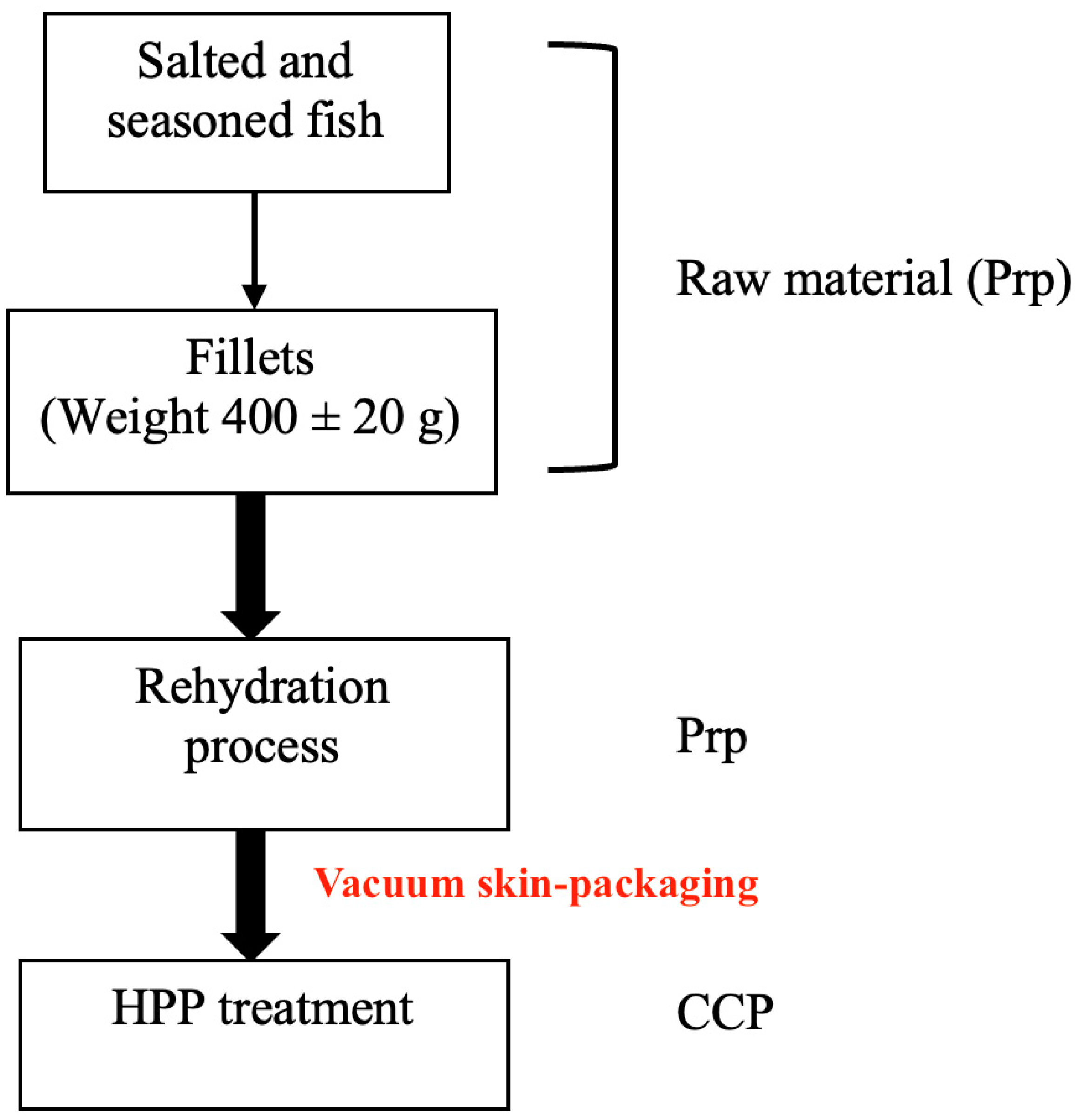
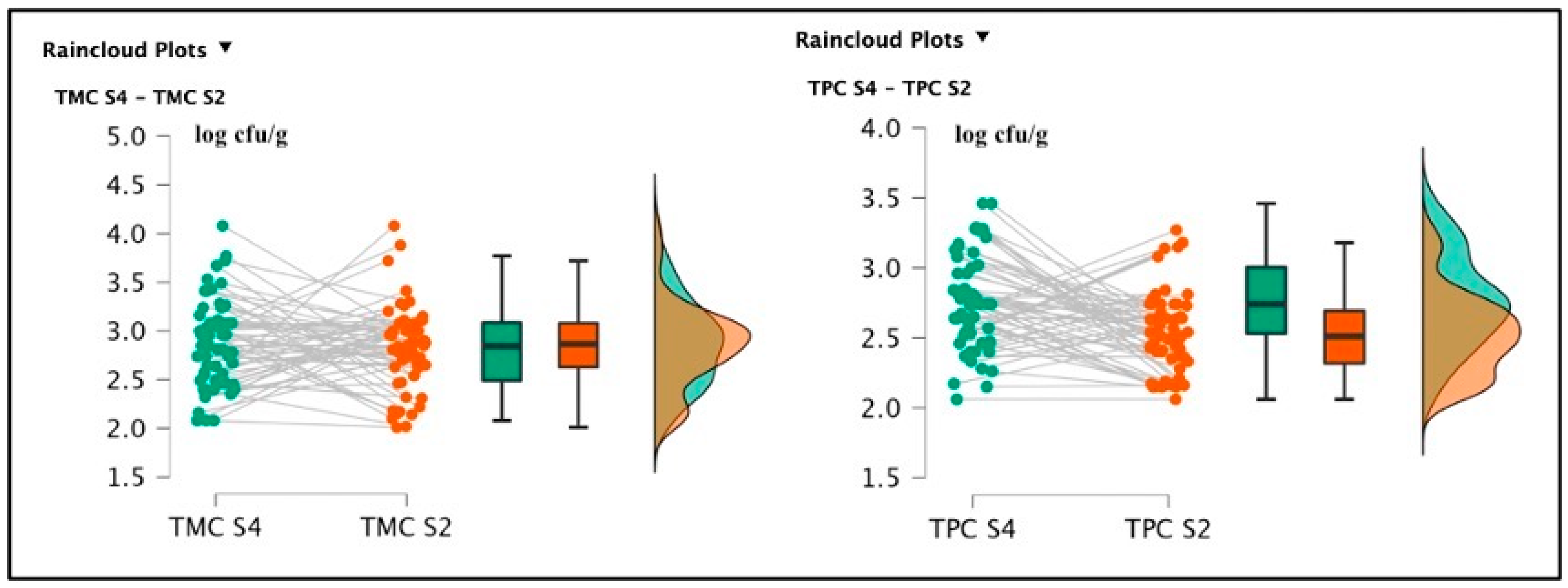
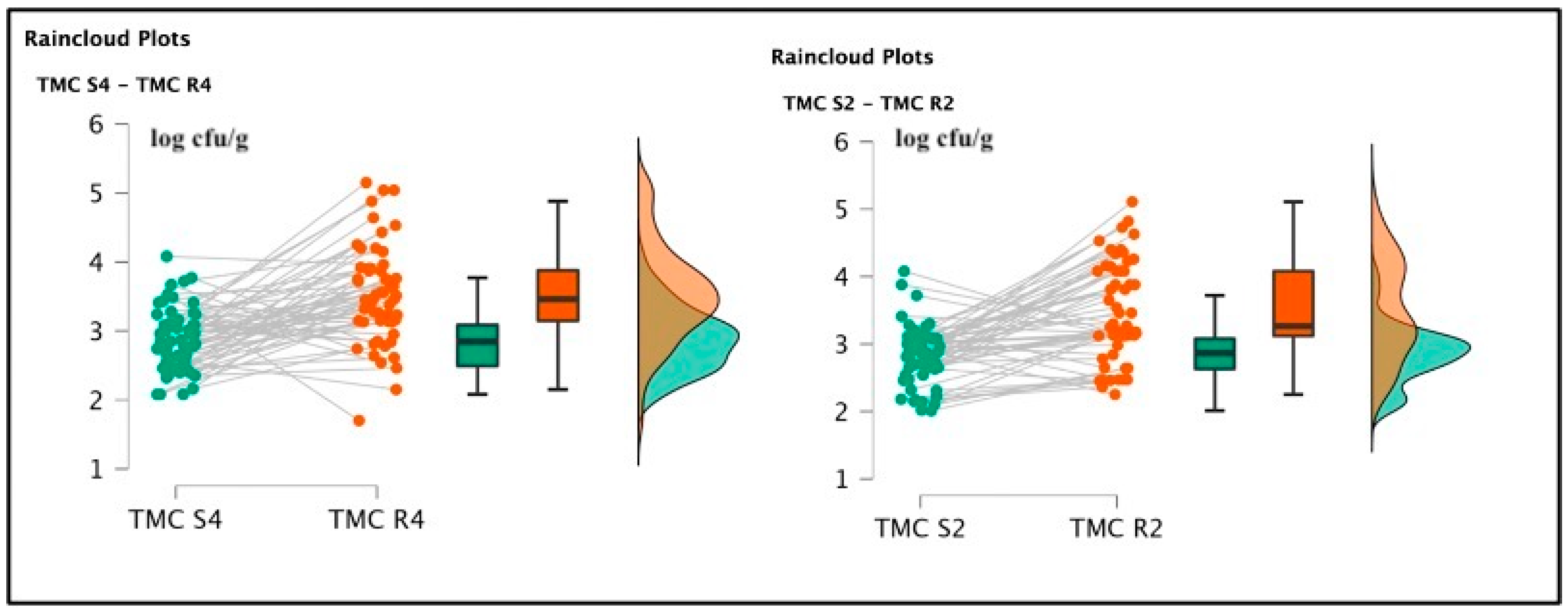
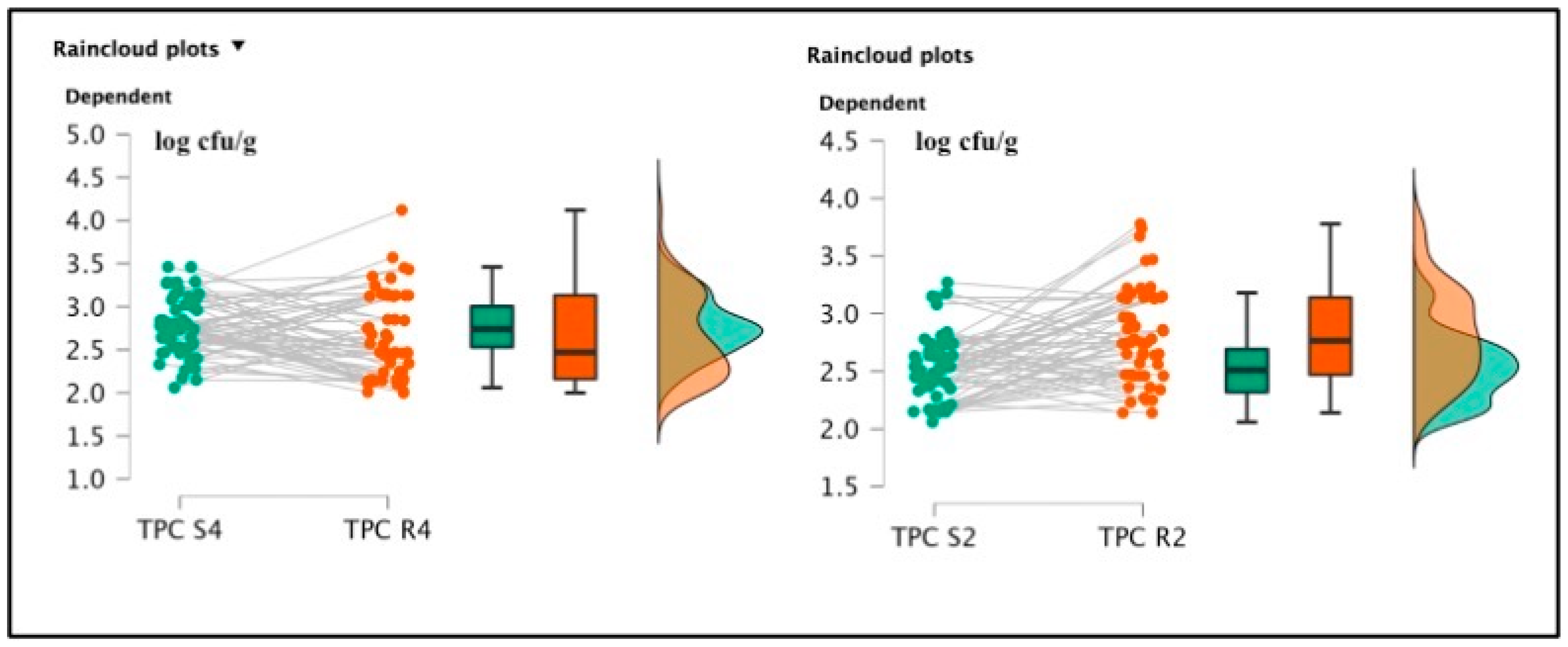
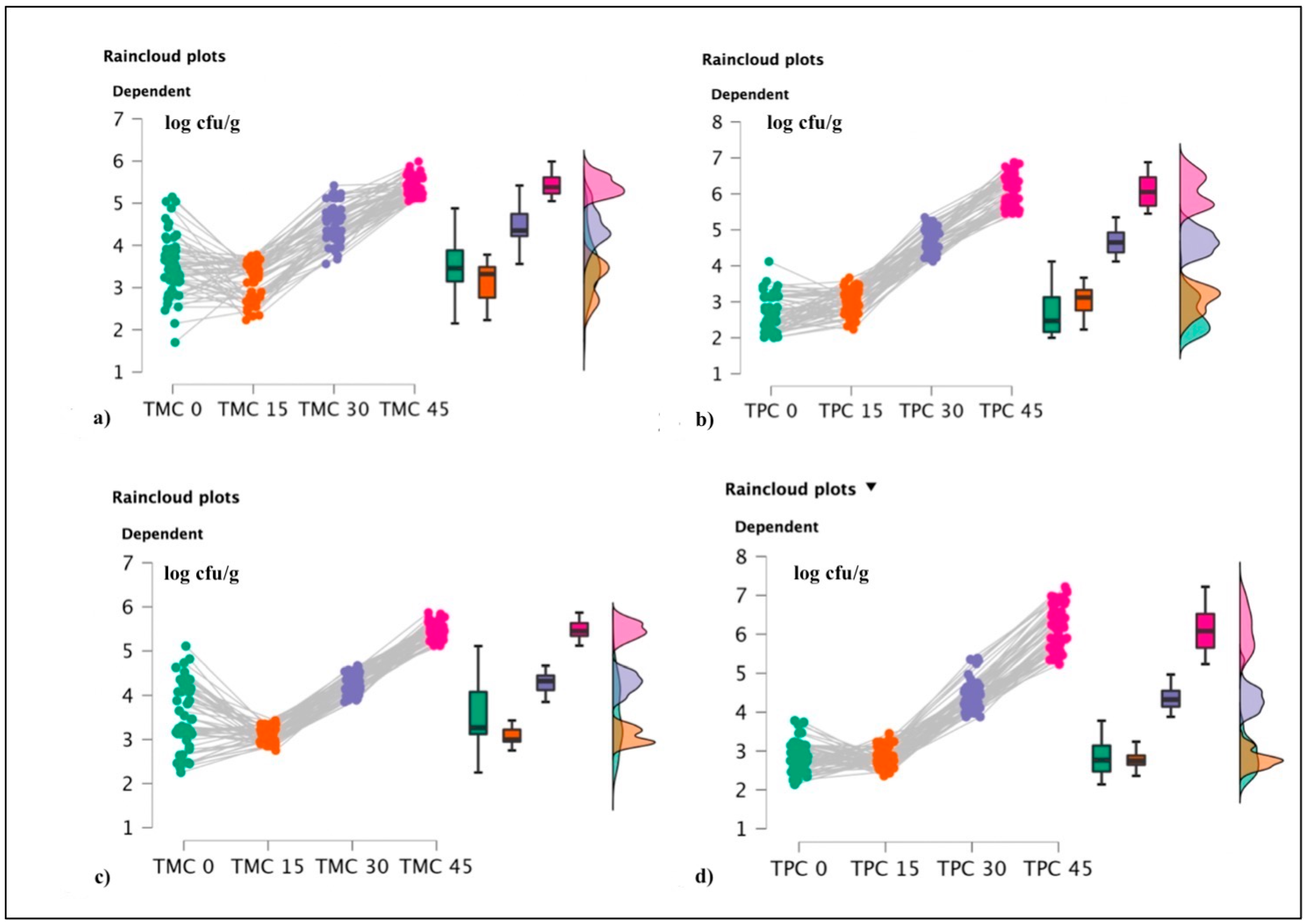
| Samples | Fish Species | Processed Products |
|---|---|---|
| 360 fish products | Gadus macrocephalus | 60 S4 |
| 60 S2 | ||
| 60 R4 | ||
| 60 R2 | ||
| 30 HPP OTR1-4 | ||
| 30 HPP OTR1-2 | ||
| 30 HPP OTR2-4 | ||
| 30 HPP OTR2-2 |
| Chemical Parameters | International Standard | Description |
|---|---|---|
| Cd, Pb, and Hg (mg/Kg) | ISO 15763:2010 | Foodstuffs—Determination of trace elements—Determination of arsenic, cadmium, mercury, and lead in foodstuffs by inductively coupled plasma mass spectrometry (ICP-MS) after pressure digestion [12]. |
| ISO 13805:2014 | Foodstuffs—Determination of trace elements—Pressure digestion [13]. | |
| pH | ISO 2917:1999 | Measurement of pH—Reference method [14]. |
| aw | ISO 21807:2004 | Microbiology of food and animal foodstuffs—Determination of water activity [15]. |
| NaCl (percentage) | AOAC 937.09 | Salt content (chlorine as sodium chloride) in seafood [16]. |
| Bacterial Strain | Standards | Description |
|---|---|---|
| Total Mesophilic Count (TMC) | ISO 4833:20 | Microbiology of the food chain—Horizontal method for the enumeration of microorganisms—Part 1: Colony count at 30 °C by the pour plate technique [17]. |
| Total Psychrophilic Count (TPC) | ISO 17410:2019 | Microbiology of the food chain—Horizontal method for the enumeration of psychrotrophic microorganisms [18]. |
| Listeria monocytogenes | ISO 11290-1:2017 ISO 11290-2:2017 | Horizontal method for the detection and enumeration of Listeria monocytogenes and Listeria spp.—Part 1: Detection method; Part 2: Enumeration method [19]. |
| Salmonella spp. | ISO 6579-1:2020 ISO 6579-2:2020 | Horizontal method for the detection, enumeration, and serotyping of Salmonella.—Part 1: Detection method; Part 2: Enumeration method [20]. |
| Coagulase-positive staphylococci enumeration | ISO 6888-1:2018 | Horizontal method for the enumeration of coagulase-positive staphylococci (Staphylococcus aureus and other species)—Part 1: Method using Baird–Parker agar medium [21]. |
| Pseudomonas spp. | ISO 13720:2010 | Enumeration of presumptive Pseudomonas spp. [22]. |
| Escherichia coli (positive beta-glucuronidase) | ISO 16649-2:2001 | Horizontal method for the enumeration of beta-glucuronidase-positive Escherichia coli—Part 2: Colony count technique at 44 degrees C using 5 bromo-4-chloro-3-indolyl beta-D-glucuronide [23]. |
| Total Coliform count | ISO 4832:2006 | Horizontal method for the enumeration of coliforms [24]. |
| Enterobacteriaceae count | ISO 21528-2:2017 | Horizontal method for the detection and enumeration of Enterobacteriaceae—Part 2: Colony count technique [25]. |
| Vibrio cholerae and V. parahaemolyticus count | ISO 21872-1:2017 | Horizontal method for the determination of Vibrio spp.—Part 1: Detection of potentially enteropathogenic Vibrio parahaemolyticus, Vibrio cholerae, and Vibrio vulnificus [26]. |
| Total lactic bacterial count | ISO 15214:1998 | Horizontal method for the enumeration of mesophilic lactic acid bacteria—Colony count technique at 30 degrees C [27]. |
| Products | pH | aw | NaCl (%) |
|---|---|---|---|
| S4 | 6.4 ± 0.1 | 0.75 ± 0.01 | 17.65 ± 1.13% |
| S2 | 6.2 ± 0.1 | 0.76 ± 0.02 | 17.14 ± 0.72% |
| R4 | 6.7 ± 0.2 | 0.96 ± 0.01 | 1.94 ± 0.45% |
| R2 | 6.6 ± 0.1 | 0.96 ± 0.01 | 1.74 ± 0.37% |
| HPP OTR1-4 | 6.5 ± 0.1 | 0.97 ± 0.02 | 1.99 ± 0.46% |
| HPP OTR1-2 | 6.5 ± 0.1 | 0.96 ± 0.01 | 1.85 ± 0.42% |
| HPP OTR2-4 | 6.4 ± 0.2 | 0.96 ± 0.01 | 1.82 ± 0.35% |
| HPP OTR2-2 | 6.6 ± 0.1 | 0.96 ± 0.01 | 1.90 ± 0.44% |
| Microbiological Factors | Obtained Results | Maximum Values |
|---|---|---|
| Listeria monocytiogenes | Absence | Absence in 25 g/products (EU Reg. No. 2073/2005) |
| Salmonella spp. | Absence | Absence in 25 g/products (EU Reg. No. 2073/2005) |
| Coagulase-positive staphylococci enumeration | Absence | 1 log cfu/g [21] |
| Pseudomonas spp. | ||
| Escherichia coli | Absence | Absence in 25 g/products (EU Reg. No. 2073/2005) |
| Total colifomr count | Absence | 1 log cfu/g [24] |
| Enterobatteriacea count | Absence | 1 log cfu/g [25] |
| Vibrio cholarae and V. parahaemolyticus counts | Absence | <1 log cfu/g [26] |
| Total lactic bacterial count | <1 log cfu/g | <1 log cfu/g [27] |
| Friedmann Test | Sample Types | χ2 | df | Asymp. Sig. | |||
| TMC 4 (t:0–t:45) | 153.183 | 3 | <0.001 | ||||
| TPC 4 (t:0–t:45) | 168.480 | 3 | <0.001 | ||||
| TMC 2 (t:0–t:45) | 148.820 | 3 | <0.001 | ||||
| TPC 2 (t:0–t:45) | 162.020 | 3 | <0.001 | ||||
| Wilcoxon signed-rank tests | Post hoc comparisons | TMC4 t:0–15 | TMC4 t:0–30 | TMC4 t:0–45 | TMC4 t:15–30 | TMC4 t:15–45 | TMC4 t:30–45 |
| Z | −3.242 | −6.088 | −6.680 | −6.736 | −6.681 | −6.680 | |
| Asymp. Sig. (2-tailed) | p < 0.001 | p < 0.001 | p < 0.001 | p < 0.001 | p < 0.001 | p < 0.001 | |
| r | 0.55 | 0.78 | 0.86 | 0.87 | 0.86 | 0.86 | |
| Post hoc comparisons | TPC4 t:0–15 | TPC4 t:0–30 | TPC4 t:0–45 | TPC4 t:15–30 | TPC4 t:15–45 | TPC4 t:30–45 | |
| Z | −4.814 | −6.736 | −6.736 | −6.737 | −6.736 | −6.736 | |
| Asymp. Sig. (2-tailed) | p < 0.001 | p < 0.001 | p < 0.001 | p < 0.001 | p < 0.001 | p < 0.001 | |
| r | 0.62 | 0.87 | 0.87 | 0.87 | 0.87 | 0.87 | |
| Post hoc comparisons | TMC2 t:0–15 | TMC2 t:0–30 | TMC2 t:0–45 | TMC2 t:15–30 | TMC2 t:15–45 | TMC2 t:30–45 | |
| Z | −3.534 | −5.694 | −6.736 | −6.738 | −6.736 | −6.736 | |
| Asymp. Sig. (2-tailed) | p < 0.001 | p < 0.001 | p < 0.001 | p < 0.001 | p < 0.001 | p < 0.001 | |
| r | 0.46 | 0.73 | 0.87 | 0.87 | 0.87 | 0.87 | |
| Post hoc comparisons | TPC2 t:0–15 | TPC2 t:0–30 | TPC2 t:0–45 | TPC2 t:15–30 | TPC2 t:15–45 | TPC2 t:30–45 | |
| Z | −0.280 | −6.736 | −6.736 | −6.737 | −6.736 | −6.736 | |
| Asymp. Sig. (2-tailed) | p < 0.001 | p < 0.001 | p < 0.001 | p < 0.001 | p < 0.001 | p < 0.001 | |
| r | 0.04 | 0.87 | 0.87 | 0.87 | 0.87 | 0.87 | |
| Friedmann Test | Sample types | Time | χ2 | df | Asymp. Sig. | |
| OTR1–4; OTR1–2; OTR2–4; OTR2–2 | t:0 | 25.456 | 3 | <0.001 | ||
| t:15 | 46.145 | 3 | <0.001 | |||
| t:30 | 41.010 | 3 | <0.001 | |||
| t:45 | 10.030 | 3 | 0.018 | |||
| Post hoc evaluations | TMC t:0 OTR1–4 vs. OTR1–2 | TMC t:0 OTR1–2 vs. OTR2–4 | TMC t:0 OTR2–4 vs. OTR2–2 | TMC t:0 OTR1–4 vs. OTR2–4 | TMC t:0 OTR1–4 vs. OTR2–2 | TMC t:0 OTR1–2 vs. OTR2–2 |
| z | −0.714 | −1.938 | −1.288 | −2.996 | −4.098 | −3.438 |
| Asymp. sig. | 0.475 | 0.053 | 0.198 | 0.003 | <0.001 | <0.001 |
| r | 0.08 | 0.35 | 0.23 | 0.55 | 0.75 | 0.63 |
| Post hoc evaluations | TMC t:15 OTR1–4 vs. OTR1–2 | TMC t:015 OTR1–2 vs. OTR2–4 | TMC t:15 OTR2–4 vs. OTR2–2 | TMC t:15 OTR1–4 vs. OTR2–4 | TMC t:15 OTR1–4 vs. OTR2–2 | TMC t:15 OTR1–2 vs. OTR2–2 |
| z | −2.757 | −4.783 | −4.618 | −4.206 | −0.951 | −1.925 |
| Asymp. sig. | 0.006 | <0.001 | <0.001 | <0.001 | 0.341 | 0.054 |
| r | 0.50 | 0.87 | 0.84 | 0.77 | 0.17 | 0.35 |
| Post hoc evaluations | TMC t:30 OTR1–4 vs. OTR1–2 | TMC t:30 OTR1–2 vs. OTR2–4 | TMC t:30 OTR2–4 vs. OTR2–2 | TMC t:30 OTR1–4 vs. OTR2–4 | TMC t:30 OTR1–4 vs. OTR2–2 | TMC t:30 OTR1–2 vs. OTR2–2 |
| z | −1.341 | −4.546 | −4.372 | −4.659 | −3.159 | −2.055 |
| Asymp. sig. | 0.180 | <0.001 | <0.001 | <0.001 | 0.002 | 0.040 |
| r | 0.24 | 0.83 | 0.79 | 0.85 | 0.57 | 0.37 |
| Post hoc evaluations | TMC t:45 OTR1–4 vs. OTR1–2 | TMC t:45 OTR1–2 vs. OTR2–4 | TMC t:45 OTR2–4 vs. OTR2–2 | TMC t:45 OTR1–4 vs. OTR2–4 | TMC t:45 OTR1–4 vs. OTR2–2 | TMC t:45 OTR1–2 vs. OTR2–2 |
| z | −1.990 | −1.008 | −0.076 | −2.428 | −2.613 | −1.352 |
| Asymp. sig. | 0.047 | 0.313 | 0.940 | 0.015 | 0.009 | 0.176 |
| r | 0.36 | 0.18 | 0.01 | 0.44 | 0.47 | 0.25 |
| Friedmann Test | Sample Types | Time | χ2 | df | Asymp. Sig. | |
| OTR1–4; OTR1–2; OTR2–4; OTR2–2 | t:0 | 21.949 | 3 | <0.001 | ||
| t:15 | 31.455 | 3 | <0.001 | |||
| t:30 | 62.185 | 3 | <0.001 | |||
| t:45 | 72.564 | 3 | <0.001 | |||
| Post hoc evaluations | TPC t:0 OTR1–4 vs. OTR1–2 | TPC t:0 OTR1–2 vs. OTR2–4 | TPC t:0 OTR2–4 vs. OTR2–2 | TPC t:0 OTR1–4 vs. OTR2–4 | TPC t:0 OTR1–4 vs. OTR2–2 | TPC t:0 OTR1–2 vs. OTR2–2 |
| z | −0.854 | −3.340 | −0.444 | −2.680 | −3.010 | −3.436 |
| Asymp. sig. | 0.393 | <0.001 | 0.657 | 0.007 | 0.003 | <0.001 |
| r | 0.15 | 0.61 | 0.08 | 0.49 | 0.55 | 0.63 |
| Post hoc evaluations | TPC t:15 OTR1–4 vs. OTR1–2 | TPC t:015 OTR1–2 vs. OTR2–4 | TPC t:15 OTR2–4 vs. OTR2–2 | TPC t:15 OTR1–4 vs. OTR2–4 | TPC t:15 OTR1–4 vs. OTR2–2 | TPC t:15 OTR1–2 vs. OTR2–2 |
| z | −0.465 | −4.314 | −4.680 | −4.105 | −0.802 | −0.865 |
| Asymp. sig. | 0.642 | <0.001 | <0.001 | <0.001 | 0.422 | 0.387 |
| r | 0.08 | 0.78 | 0.85 | 0.75 | 0.15 | 0.15 |
| Post hoc evaluations | TPC t:30 OTR1–4 vs. OTR1–2 | TPC t:30 OTR1–2 vs. OTR2–4 | TPC t:30 OTR2–4 vs. OTR2–2 | TPC t:30 OTR1–4 vs. OTR2–4 | TPC t:30 OTR1–4 vs. OTR2–2 | TPC t:30 OTR1–2 vs. OTR2–2 |
| z | −4.599 | −4.762 | −2.561 | −4.536 | −2.790 | −4.705 |
| Asymp. sig. | <0.001 | <0.001 | 0.010 | <0.001 | 0.005 | <0.001 |
| r | 0.84 | 0.87 | 0.47 | 0.83 | 0.51 | 0.86 |
| Post hoc evaluations | TPC t:45 OTR1–4 vs. OTR1–2 | TPC t:45 OTR1–2 vs. OTR2–4 | TPC t:45 OTR2–4 vs. OTR2–2 | TPC t:45 OTR1–4 vs. OTR2–4 | TPC t:45 OTR1–4 vs. OTR2–2 | TPC t:45 OTR1–2 vs. OTR2–2 |
| z | −1.094 | −4.783 | −0.720 | −4.783 | −4.783 | −4.783 |
| Asymp. sig. | 0.274 | <0.001 | 0.472 | <0.001 | <0.001 | <0.001 |
| r | 0.20 | 0.87 | 0.13 | 0.87 | 0.87 | 0.87 |
Disclaimer/Publisher’s Note: The statements, opinions and data contained in all publications are solely those of the individual author(s) and contributor(s) and not of MDPI and/or the editor(s). MDPI and/or the editor(s) disclaim responsibility for any injury to people or property resulting from any ideas, methods, instructions or products referred to in the content. |
© 2023 by the authors. Licensee MDPI, Basel, Switzerland. This article is an open access article distributed under the terms and conditions of the Creative Commons Attribution (CC BY) license (https://creativecommons.org/licenses/by/4.0/).
Share and Cite
Ferri, G.; Lauteri, C.; Scattolini, M.; Vergara, A. Shelf Life and Safety of Vacuum Packed HPP-Treated Soaked Cod Fillets: Effects of Salt Content and Multilayer Plastic Film. Foods 2023, 12, 179. https://doi.org/10.3390/foods12010179
Ferri G, Lauteri C, Scattolini M, Vergara A. Shelf Life and Safety of Vacuum Packed HPP-Treated Soaked Cod Fillets: Effects of Salt Content and Multilayer Plastic Film. Foods. 2023; 12(1):179. https://doi.org/10.3390/foods12010179
Chicago/Turabian StyleFerri, Gianluigi, Carlotta Lauteri, Mauro Scattolini, and Alberto Vergara. 2023. "Shelf Life and Safety of Vacuum Packed HPP-Treated Soaked Cod Fillets: Effects of Salt Content and Multilayer Plastic Film" Foods 12, no. 1: 179. https://doi.org/10.3390/foods12010179
APA StyleFerri, G., Lauteri, C., Scattolini, M., & Vergara, A. (2023). Shelf Life and Safety of Vacuum Packed HPP-Treated Soaked Cod Fillets: Effects of Salt Content and Multilayer Plastic Film. Foods, 12(1), 179. https://doi.org/10.3390/foods12010179






